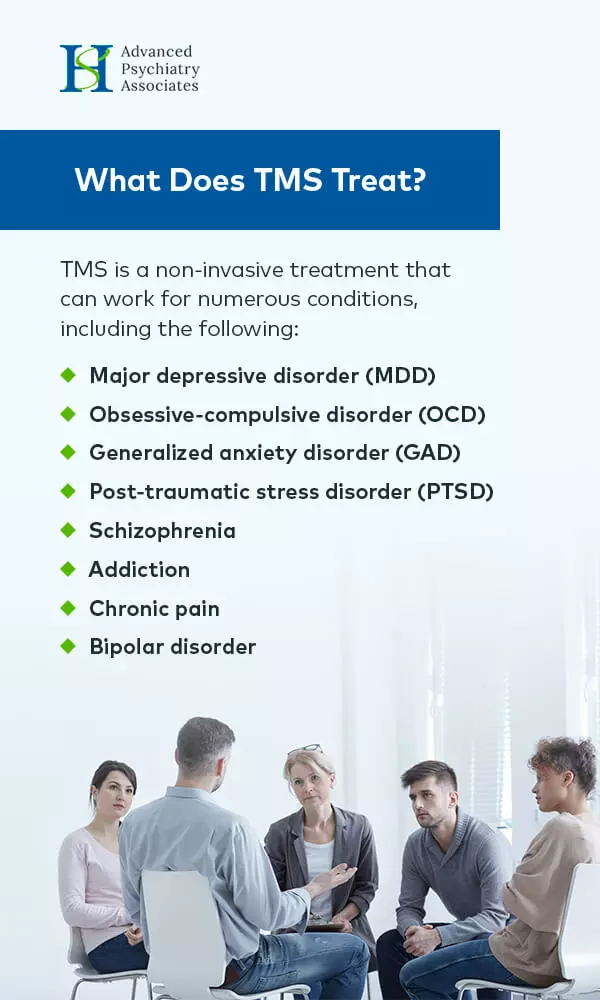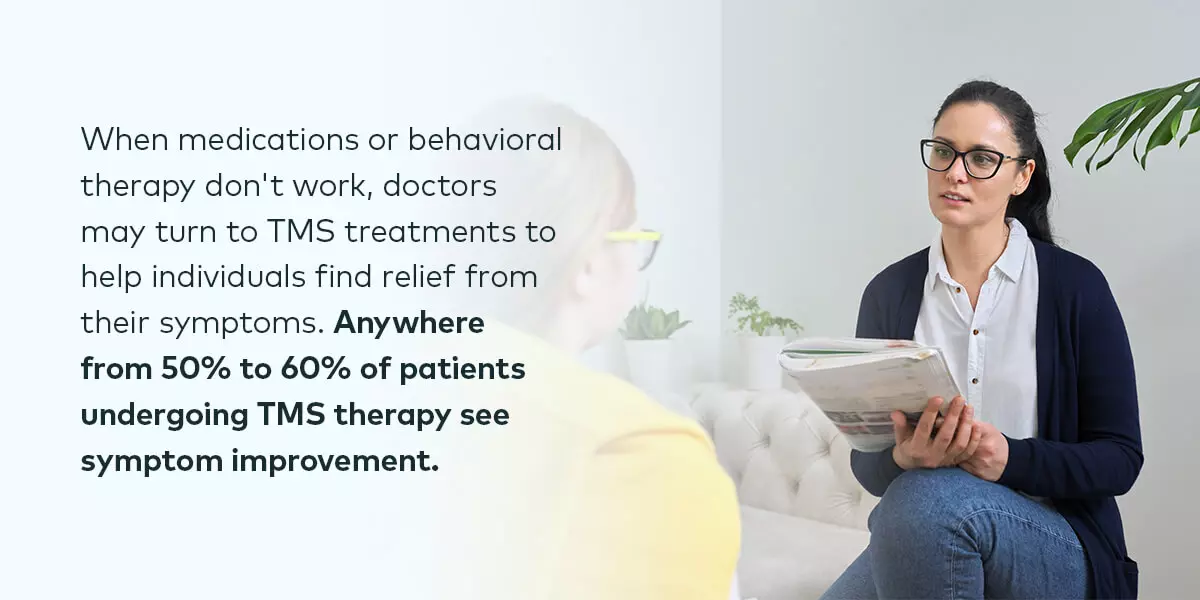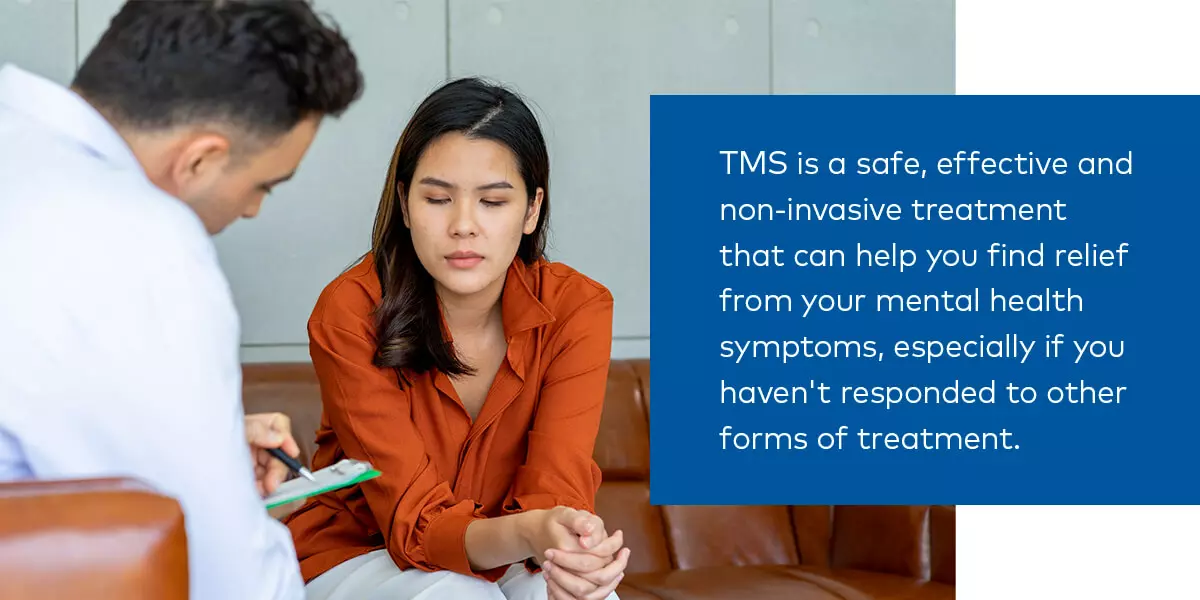About 17.3 million individuals in the United States struggle with major depression. Some of these individuals have treatment-resistant depression, which is when the condition doesn’t respond to or improve from common forms of treatment, such as antidepressants or psychotherapy. While treating this type of depression can be more challenging, there are options to help manage symptoms and improve quality of life.
Transcranial magnetic stimulation (TMS) is a treatment that can help individuals find relief from their mental health symptoms. TMS therapy can be even more effective when combined with other types of treatment. Continue reading to learn how TMS therapy can help, including its many benefits.
What Is TMS Therapy?
TMS is a clinical treatment that stimulates the brain using electromagnetic pulses. The pulses energize nerve cells, which have the potential to improve various mental and neurological conditions. TMS therapy is often used to treat depression but has other applications. The Food and Drug Administration (FDA) approved TMS therapy in 2008 for treatment-resistant or major depression, but that’s not the only condition TMS can treat.
TMS can help individuals find relief from depression and other conditions, such as general anxiety disorder (GAD), post-traumatic stress disorder (PTSD) and obsessive-compulsive disorder (OCD), that medication or behavioral therapy fails to improve. Learn more below about the specifics of TMS therapy and its effectiveness as one of many depression treatments.

What Does TMS Treat?
TMS is a non-invasive treatment that can work for numerous conditions, including the following:
- Major depressive disorder (MDD): In most cases, TMS is used to treat MDD. TMS therapy for depression helps individuals with treatment-resistant depression find relief from their symptoms where other methods have failed. TMS therapy uses magnetic pulses to target parts of the brain responsible for mood and other depression symptoms.
- Obsessive-compulsive disorder (OCD): As more people started to succeed in alleviating their depression symptoms with TMS treatment, the FDA approved TMS for OCD. Like with depression, people with OCD will often have the option of TMS if they’ve been unresponsive to other common forms of treatment. While TMS treatments for depression aim to increase brain activity, TMS treatments for OCD try to reduce the activity responsible for compulsive behaviors and thought patterns.
- Generalized anxiety disorder (GAD): Sometimes, people with GAD develop the condition as a symptom of other conditions, such as MDD or OCD. In these cases, TMS therapy for anxiety is an option and can relieve symptoms by reducing activity in specific areas of the brain.
- Post-traumatic stress disorder (PTSD): TMS therapy for PTSD can help effectively reduce symptoms caused by traumatic events and experiences. Individuals who undergo TMS treatment for PTSD often experience improvement in their condition since TMS can target areas specific to anxiety, worry and fear. TMS is also effective for individuals with PTSD when combined with cognitive therapy.
- Schizophrenia: TMS can help reduce the overactive part of the brain responsible for auditory hallucinations in people with schizophrenia. There isn’t enough evidence to suggest that the therapy could treat visual hallucinations or reduce all schizophrenia symptoms, but people can find some relief from TMS.
- Addiction: One study found that TMS can help reduce nicotine cravings in individuals by influencing dopamine, the chemical responsible for pleasure. Since TMS can help with nicotine addiction, it can potentially do the same for other types of addiction involving dopamine. Still, more research must be done to confirm if it’s an effective treatment for multiple types of addiction.
- Chronic pain: TMS can help treat chronic pain, which sometimes happens simultaneously with depression. By alleviating depression symptoms, TMS can help individuals find relief from their pain. TMS can also target neurotransmitters responsible for pain to help individuals find relief.
- Bipolar disorder: TMS treatment has shown promising potential in reducing depressive symptoms in people with bipolar disorder, as well as assisting with bipolar maintenance care and treating bipolar mixed states.
The applications of TMS continue to grow as more research is done on the treatment. While TMS can treat many conditions, it’s primarily used to fight treatment-resistant depression.
How Does TMS Treatment Work?
A technician will administer TMS treatment in an outpatient medical clinic. TMS treatment uses electromagnetic pulses that are delivered through coils placed on specific areas of the head to target certain brain regions. The technician will place the coils in the area that will provide the most significant effect. The magnetic pulses encourage neurons to fire in underactive regions in people with depression. Ideally, TMS treatment will alter brain activity in the target sites, with the expected result of decreased depression.
Before starting treatment, you’ll need to remove anything from your person that may be sensitive to magnets, such as jewelry or clothing chains. Here’s what you can expect from a typical TMS treatment:
- Beforehand, your technician may have you wear ear protection since the magnets can make a lot of noise as they pulse. Anesthesia is not required for this procedure. Your technician will try to make you as comfortable as possible.
- For your first session, your technician will have to measure your head to determine the best placement for the TMS coils. These measurements will also be used to personalize the settings on the other TMS machinery.
- Once the measurements are complete, your technician will place the magnetic coil toward the front of your head to target the front of the brain. They’ll release the magnetic impulses, which could feel like a knocking or tapping sensation.
- Treatment can last up to 60 minutes, but it’s non-invasive, so you can drive yourself home and resume your regular activities right after the procedure. For treatment to be effective, it’s recommended to go five times per week for up to six weeks. After the initial treatment round, some people find success with continuing treatment at a reduced frequency, such as once a week or every other week. Your provider will help determine how you can receive maximum treatment benefits and what frequency is needed to maintain results.

Effectiveness of TMS Therapy
TMS therapy is most commonly used to treat treatment-resistant depression. When medications or behavioral therapy don’t work, doctors may turn to TMS treatments to help individuals find relief from their symptoms. Anywhere from 50% to 60% of patients undergoing TMS therapy see symptom improvement. About one-third of these individuals need no further TMS treatments. Others may have weekly, bi-weekly or monthly maintenance sessions after the initial round of treatment.
TMS therapy is effective for various individuals who struggle with treatment-resistant depression and other conditions. While the treatment may not work for everyone, it can be a valuable tool to help patients improve their quality of life. TMS is also safe and non-invasive, making it a quality alternative to more intrusive types of treatment.
Advantages of TMS Therapy
TMS provides another treatment option for individuals who have not had success with other forms of treatment. There are numerous advantages of TMS therapy, which include:
- Lasting results: One study shows that approximately 58% of people in TMS therapy respond to treatment, and 37% of patients have a full remission once they complete their entire treatment. Other studies show even more significant results. These results can be long-lasting, with some individuals requiring additional treatment to sustain their results.
- Fewer side effects: Depression medications often come with a long list of potential side effects, and a significant number of patients experience at least one. Many people’s lives can be disrupted when they experience side effects such as weight gain, sexual dysfunction and chronic fatigue. TMS can provide treatment without the unwelcomed symptoms if these side effects become bothersome. Some people experience no side effects from TMS, but others may have mild headaches or tingles from the stimulation. These side effects only tend to last a short time after treatment, allowing you to get back to living.
- Non-invasive treatment: One of the main benefits of TMS treatment is that it’s non-invasive. Treatment is simple, and you won’t have any downtime once it’s complete. You can drive home, go to work and return to your regular activities as soon as possible. Other treatments can make you feel tired or dizzy, requiring family or friends to drive you home while you recover. TMS provides an alternative for people who need to return to their lives immediately after treatment.
- Effectiveness: TMS treatment can be more effective for specific individuals, particularly those with treatment-resistant depression. About 66% of individuals with treatment-resistant depression saw improvement in their symptoms. Part of the reason that TMS is more effective is that it stimulates parts of the brain that are often underactive in people with depression.
- Reduced need for medications: TMS can be effective enough that people with treatment-resistant depression can stop taking prescription drugs. TMS treatment can replace medications and eliminate uncomfortable side effects and even the potential for medication addiction.
The benefits of TMS therapy are extensive, but it’s also important to be aware of the potential drawbacks. A few disadvantages include:
- Multiple visits: TMS treatment requires multiple sessions to be effective, meaning you will need to return to the office frequently. You’ll need about five treatments a week for up to six weeks, which can be inconvenient for some people. However, while completing treatment can take some time, many people with treatment-resistant depression feel TMS is worth the time.
- Discomfort: Some people experience tapping or knocking sensations during treatment, which they describe as uncomfortable. However, these feelings are minimal and temporary. In most cases, these feelings subside as soon as treatment is complete.
- Insurance coverage: Policies between insurance companies vary. Some companies will require you to try antidepressants first, but this isn’t applicable to all insurance providers. Talk with your insurance company or a TMS provider to determine the likelihood of being covered for treatment.
For many people, the benefits of TMS far outweigh the drawbacks. TMS therapy can help you find relief that you may be unable to receive through other types of treatment, such as antidepressants or psychotherapy.
Using TMS Therapy With Other Depression Treatments
TMS therapy can often be used alongside other treatments to achieve better results, particularly behavioral therapy. Some treatments you can combine with TMS include:
- Medication: While many people seeking TMS therapy do so because antidepressants are ineffective on their own, combining the two forms of treatment can boost the effectiveness of each. Your doctor may have you continue antidepressants after you finish TMS treatment to sustain your results for as long as possible. If you have treatment-resistant depression, using these two treatment methods can help you find relief.
- Therapy: Many people who get treatment for depression go through some form of behavioral therapy to get to the root of their problem. For some people, their depression is caused by a chemical imbalance in the brain, while others develop depression due to their environment or trauma. Therapy helps individuals tackle these problems and utilize healthy coping mechanisms to improve their mood and reaction to various stimuli, and it can also lead to sustained results during and after TMS.
- Ketamine: Ketamine is a medication sometimes used for treatment-resistant depression. TMS therapy and ketamine injections can be combined to help individuals who struggle with MDD and have found no relief through other means. Some people who combine these two treatments experience rapid relief from their symptoms with fewer required sessions, making the combination of TMS therapy and ketamine injections a quality treatment option for individuals with moderate to severe depression.
Combining TMS therapy with other treatments can help you find relief from your symptoms sooner, particularly if you’re struggling with treatment-resistant depression, and it can also help maintain your relief for a longer period. Talk to your doctor about your options if you feel like medication and therapy aren’t enough on their own.

Is TMS Right for You?
TMS is a safe, effective and non-invasive treatment that can help you find relief from your mental health symptoms, especially if you haven’t responded to other forms of treatment. If you’re considering TMS, talk with your doctor about your options. They’ll review your medical history and current health before recommending TMS.
TMS may not be ideal for specific individuals. Before starting TMS treatment, tell your doctor if you:
- Have metals in your head, such as metal plates, permanent piercings or cochlear implants. The magnetic coils could cause these metals to heat or shift, putting you at risk for injury.
- Are currently using prescription or illicit stimulants.
- Have a medical history of seizures or epilepsy.
- Have a medical condition that can increase your probability of seizures.
You may still be a viable candidate for TMS with any of the above stipulations, but it’s always a good idea to discuss treatment with your doctor beforehand to ensure your safety. Note that while people with metal in their heads may need to avoid treatment, people with dental fillings or braces can safely receive TMS.
Try TMS With Advanced Psychiatry Associates

Depression can significantly impact your quality of life, making you think negatively and feel low regardless of what’s going on in your life. You may have tried various forms of treatment to find relief but have seen no improvement. Advanced Psychiatry Associates is here to help with our TMS treatments in the greater Sacramento area. TMS therapy has been shown to be effective with adolescents, and we treat anyone 14 years and older with a mental health disorder.
At our facility, TMS therapy is a short outpatient treatment. You can return to your life at the end of every session, and you won’t have to worry about any downtime since the procedure is generally painless and doesn’t require any sedation. Our professional staff has the knowledge and tools to perform the procedure effectively and help you find relief as soon as possible. If you’re ready to improve your quality of life and defeat depression, schedule an appointment with us today to get started.






